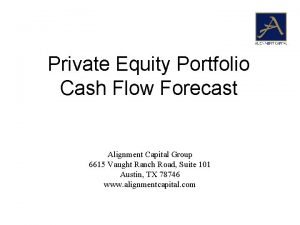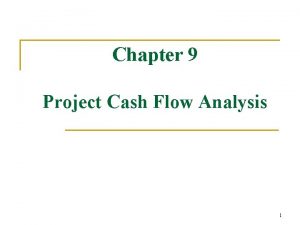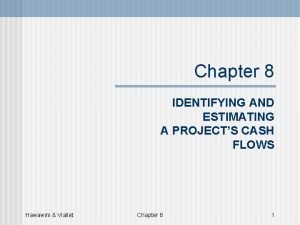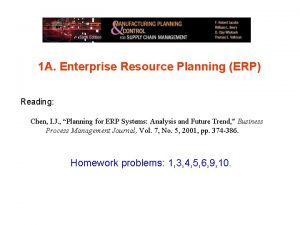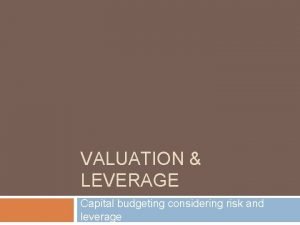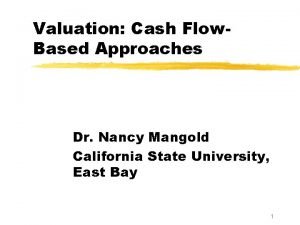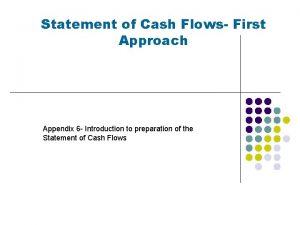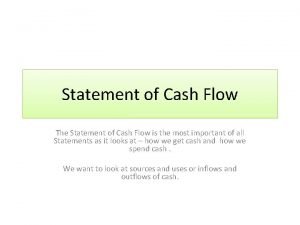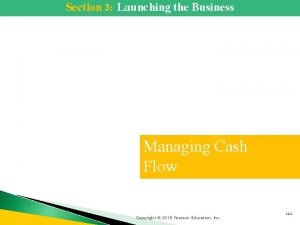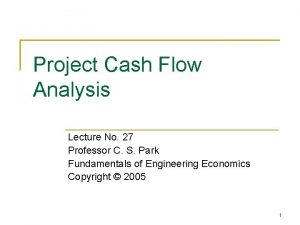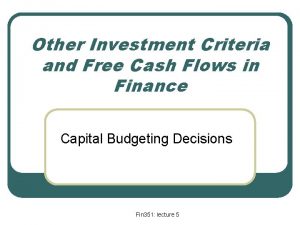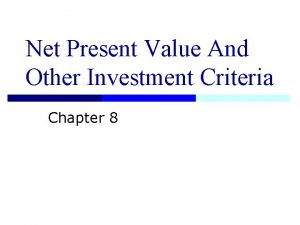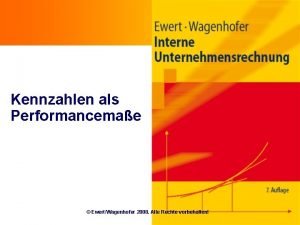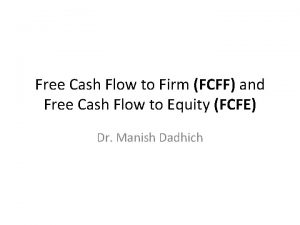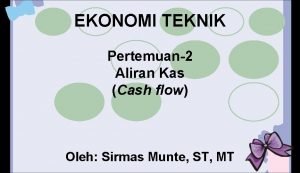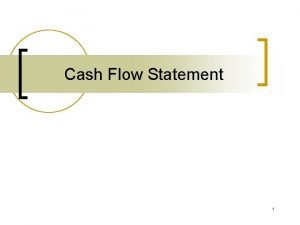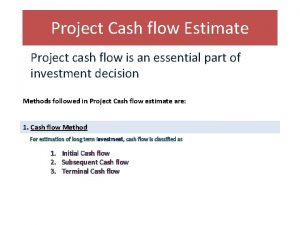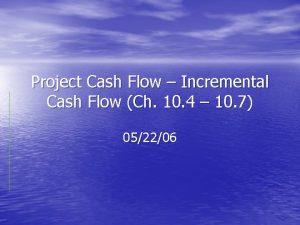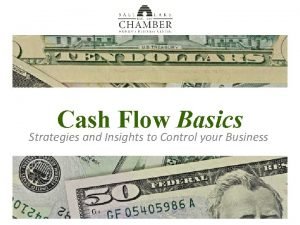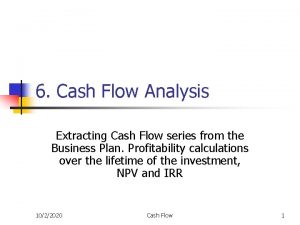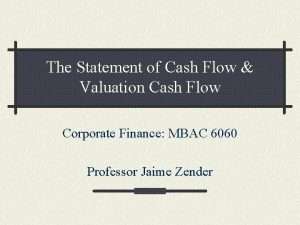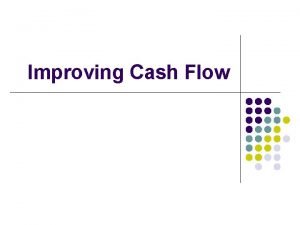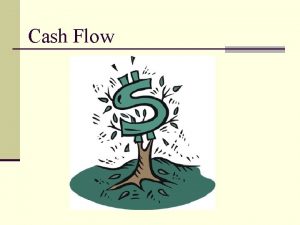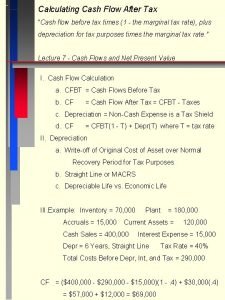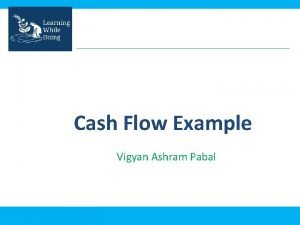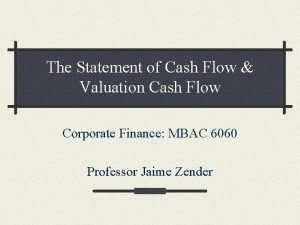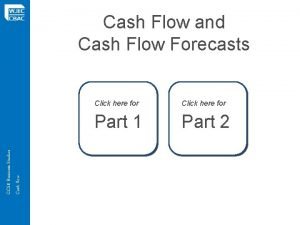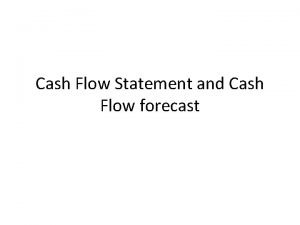Project Cash Flow Cash Flow Forecasting q In
































- Slides: 32

Project Cash Flow

<Cash Flow Forecasting q In order to make a workable project plan, the resources needed for the project and their availability must be checked. q Money is one of the most important resources. q Cash flow forecasting is required to determine whether or not the funds to execute the plan are available. q Cash flow forecasting is the forecasting of both cash in and cash out of the project.

<Cash in q. Engineering project contracts typically provide that the owner shall make progress payments of the contract amount to the prime contractor as the work progresses. q. Cash in = Cash receipt = income q. Principal components of cash in Ø Value of work actually performed in the field. The total value of work done to date is obtained in different ways, depending on the type of contract, and Ø Material stored on the site, but not yet incorporated into work, as well as any prefabrication or pre assembly work that the contractor may have done at some location other than the job site. q. A step curve is used to represent contract cash income.

<Cash in (Receipt or Income) and Revenue An income is the actual receipt of revenue. It takes into account the delays between incurring a commitment and making a money transaction. Contract revenue and income curves

<Payment Request for Unit Price Contract q The quantities of work done on unit-price contracts are determined by actual field measurement of the bid items put into place. q The total quantity accomplished to date on each bid item is multiplied by its corresponding contract unit price q All of the bid items are totaled and the value of materials stored on the site as well as any prefabrication or pre assembly work that the contractor may have done at some location other than the job site is then added. q The prescribed retainage is subtracted from this total. q The resulting figure represents the entire amount due the contractor for his work to date. The sum of all prior progress payments that have already been paid is then subtracted, this yielding the net amount of money payable to the contractor for his work that month.

<Payment Request for Lump Sum Contract q Under lump sum contract the project is divided for payment purposes into relatively few work classifications, classifications most of which are extensive and often extend over considerable portions of the construction period. Contracts progress is customarily measured in terms of estimated percentages of completion of work classifications (major job components). components q The contractor estimates the percentage completed and in place. q The total value of each work classification is multiplied by its percent completion. q To the total of completed work is added the value of all materials stored on the site. From this total is subtracted the retainage. This gives the total amount of money due the contractor up to the date of the pay request. q Form this is subtracted the amount of progress payments already made. The resulting figure gives the net amount now payable to the contractor.

<Payment Request for Negotiated Contract q Negotiated contracts of the cost-plus variety usually provide for the contractor's submission of payment vouchers to the owner at specified intervals during the life of the contract. q The contractor must make periodic accountings to the owner for the cost of the work, either to receive direct payment form the owner or to obtain further advances of funds. q A common provision is weekly reimbursement of payrolls and monthly reimbursement of all other costs, including a proportion of the contractor's fee.

<Contract Provision that Impact Cash in 1. Advanced payment 2. Progress payment 3. Materials stored on the site 4. Final Payment 5. Retention 6. …………

<Retainage = Retention q A prescribed percentage of each progress payment is usually retained by the owner in accordance with the terms of the contract. q The retainage may be held by the owner until the work receives final certification by the A/E, the owner accepts the project. q Final payment is then made to the contractor, including the accumulated retainage.

<Final Payment q After the work has been finalized and all deficiencies remedied, the owner makes formal written acceptance of the project and the contractor presents his application for final payment. q Under a lump-sum form of contract, the final payment is the final contract price less the total of all previous payment installments made. q With a unit-price contract, the final total quantities of all payment items are measured and the exact final contract price is determined. Final payment is again equal to the contract price less the sum of all progress payments previously made. q In all cases, final payment by the owner includes all retainage that has been held by him.

<Cash out q Engineering projects can make substantial demands on a contractor's cash. q Cash out = payment of costs = expense q Principal components of cash out Ø “Up-front" Up-front costs = initial expenses = start-up costs are costs necessary to start the project such as costs of moving in workers and equipment; erecting field offices, storage sheds, fences; job layout; installation of temporary electrical, water, telephone, sanitary, and other services; bonds; permits and project insurance. Ø Payment of direct job costs These include costs associated with payrolls, materials, equipment, and subcontractor payments. Ø Payments for filed overhead expense and tax. q An S-curve (a smooth curve) is used to represent contract cash out.

<Cash out (Payment of Cost = Expense) and Cost An expense is the actual payment of costs. It takes into account the delays between incurring a commitment and making a money transaction. Contract cost and expense curves

<Cash Flow q The contractor's expense on a project will typically exceed his monthly progress payment income over an appreciable part of the construction period. q The cash shortage on the project must be made up form the contractor's working capital, or money must be borrowed to provide the necessary operating funds. q "Cash flow" refers to a contractor's income and outgo of cash.

<Net Cash Flow q The net cash flow is the difference between cash out and income at any point in time. A negative net flow means expense are exceeding income, a normal situation on even a highly profitable project during the greater part of its duration. q A determination of the future rates of cash outs and cash income together with their combined effect on the project cash balance is called a "cash flow forecast". forecast

<Need to Forecast Contract Cash Flow q To determine the negative cash flow and how to cover it. q To determine the positive cash flow and how to use it (the positive cash flow of one contract may be used to handle the negative cash flow of another).

<Simplified Approach to Forecast Contract Cash Flow Contract Revenue / Income Curve 1) Produce an activity schedule in bar chart or time-scaled form. If adjustments have been made to effect allocation or leveling of resources, the schedule should reflect these adjustments. 2) Determine the value/price of each activity per week. 3) Sum up the activities weekly and then the monthly revenue in case of the admeasurement contract, or sum up the activities weekly and then the periodic revenue in case of lump sum contract. 4) Adjust the revenue for advanced payment and retention. 5) Draw cumulative adjusted revenue versus time curve. 6) Shift the above curve by the lag between submitting payment requests and receiving revenue to get the income curve.

<Simplified Approach to Forecast Contract Cash Flow Contract Cost / Expense Curve When the mark-up is uniformly spread throughout the contract, the cost/expense curve can be derived as follows: 1) If the mark-up; M, is expressed as a percentage of tender price, then: Cumulative cost = cumulative revenue * (1 - M) 2) Draw cumulative cost versus time curve. 3) Group cost headings that have the same payment delay between incurring the cost and making the payment. 4) Calculate the proportion of costs due to each group. 5) Shift the cumulative cost of each group by the specified amount to get its cumulative expense. 6) Sum up contract cumulative expenses. 7) Draw cumulative expense curve.

<Contract Cash Flow Curves Having determined the contract cumulative income and expense curves, one can combine them on one graph to represent the contract cumulative cash flow curves.

<Contract Net Cash Flow The difference between contract cumulative income and expense curves can be drawn to represent the contract cumulative net cash flow.

<Factors That Minimize Contractor's Negative Cash Flow 1) Front end rate loading: earlier items in bill of quantities carry a higher markup than later items. This reduces negative cash flows in contract early stages. 2) Reduction of delays in receiving revenue. 3) Adjustment of work schedule to late start timing. 4) Coinciding the timing of delivery of large materials orders with the submittal of the contractor's monthly pay estimate. 5) Delay in paying labor, plant hirers, materials suppliers, and subcontractors. This would reduce negative cash flows but undermine commercial confidence in the company. 6) Increasing the mark-up and reducing the retentions. 7) Increasing advance payment. 8) Achievement of maximum production in the field. 9) Quick settlement or claims.

<Example 1 • The following network shows the activates of small project. − The activates’ durations are in weeks. − The price of each activity is shown in below table. Activity Price (SR) A 20000 B 45000 C 20000 D 30000 E 16000 F 30000

<Example 1 • According to contract conditions, − the contractor will receive advanced payment of 20%. − This will be deduced from each monthly revenue. • Applications of payments will be submitted by the contractor to the client every 4 weeks and payment will be after 2 weeks from the submission of the application. • The client will deduct 10% from each payment as retention. − All retentions will be paid to the contractor with the last payment. • The ratio between project price to project cost is 1. 1 (project price /project cost = 1. 1) − there is no delay in paying the costs by the contractor. • Calculate and draw the cash flow curves (cash-in and cash-out) based on early start time.

<Example 1 ∑ =161 20%*161 10%*161 (72 -. 1*72. 2*72) (72/1. 1)

<Example 1

<Example 2 • The actives involved in a small engineering project are given in table 1 the value of the work involved in each activity is listed in the table. Activity A B C D E F G H I J Duration (Week) 5 4 5 5 5 4 6 4 3 2 Preceding Activity A A A B B, C D E F, G H, I Value of Lag +1 -2 -1 -2 with G Value (SR) 30000 20000 15000 25000 16000 18000 9000 4000

<Example 2 • The mark-up is 10% of tender value and is assumed to be uniformly distributed over the contract. • The contractor will receive an advanced payment of 10% of tender value. o This will be deduced from each monthly revenue. • Retention is 5% and is paid on contract completion. • Labor cost is assumed to be 30% of total contract cost. • The delay for other payment is one month. • Revenue is received after 4 weeks from submitting invoices. • Assuming all the activities are scheduled on their early start timings • derive income and expanse curve and contract cash flow curves.

<Example 1

<Example 2

<Example 2

<Example 2 - ve Cash out - ve + ve - ve Cash in

<Example 3 The table below lists the cumulative monthly expenses incurred by contractors and the corresponding monthly incomes which are received from the owner of a project. End of Month Cumulative Expense, (1000 SR) Cumulative Income, (1000 SR) 0 0 0 1 12 0 2 20 0 3 54 0 4 90 14 5 130 40 6 180 100 7 220 130 8 240 190 9 260 210 10 290 300 11 290 320 12 290 340 Calculate financial charges of this project if the chosen annual investment rate is 12%. If the owner makes all his payments one month later than anticipated in the table above, by what percentage will the financial charges increase?

<Example 3 36 34 34 32 32 30 30 34 28 32 26 30 24 Cost, SR 22 21 20 21 19 21 18 16 19 14 13 12 13 10 10 10 8 Cash out = Expences 6 4 4 2 00 0 0 00 1 00 2 End of Month Cumulative Expense, (10, 000 SR) Cumulative Income, (10, 000 SR) Area (10, 0000 SR) additional Area (10, 0000 SR) 3 4 0 0 Cash In Month Later Cash Inn 1. 4 0 00 4 5 1 1. 2 0 0. 6 6 7 Time, month 2 2 0 1. 6 3 5. 4 0 3. 7 8 4 9 1. 4 7. 2 % increase (29/66. 7) = 43. 5% 9 5 13 4 9. 6 1. 4 10 6 18 10 11. 5 2. 6 11 7 22 13 10 6 12 8 24 19 10 3 9 26 21 6 6 13 10 29 30 6. 5 2 14 11 29 32 * 8 12 29 34 * Total 66. 7 29 95. 7
 Strategic assessment in spm
Strategic assessment in spm Private equity cash flow forecasting
Private equity cash flow forecasting Peramalan keuangan
Peramalan keuangan Short term and long term cash forecasting
Short term and long term cash forecasting Project cash flow diagram
Project cash flow diagram Project cash flow formula
Project cash flow formula Project cash flow
Project cash flow Cash to cash cycle time
Cash to cash cycle time Cash to cash cycle time
Cash to cash cycle time Cash-in cash-out
Cash-in cash-out Production budget example
Production budget example Paid cash to establish a petty cash fund
Paid cash to establish a petty cash fund Accounting chapter 5 cash control systems answers
Accounting chapter 5 cash control systems answers Unlevered cost of equity capital
Unlevered cost of equity capital Residual cash flow
Residual cash flow Cash flow to creditors
Cash flow to creditors Cash flow adjustments
Cash flow adjustments Salaries paid in cash flow statement
Salaries paid in cash flow statement Discount cash flow method
Discount cash flow method What are the big three of cash management
What are the big three of cash management Cash flow table
Cash flow table Free cash flow to firm
Free cash flow to firm A cash-flow statement gives you important feedback on your:
A cash-flow statement gives you important feedback on your: Pasqyra e rrjedhes se parase
Pasqyra e rrjedhes se parase Pasqyra cash flow
Pasqyra cash flow Incremental cash flows
Incremental cash flows Profitability index
Profitability index Cash flow basierte kennzahlen
Cash flow basierte kennzahlen Fcfe formula from fcff
Fcfe formula from fcff Cash flow to creditors
Cash flow to creditors Noncash items refer to
Noncash items refer to Cash flow structure
Cash flow structure Annual cash flow analysis
Annual cash flow analysis

